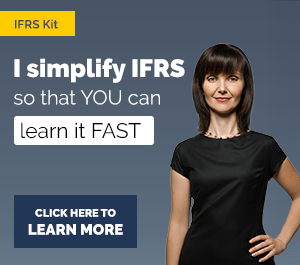Complete IFRS Consolidation Lecture: IFRS 3 | IFRS 10 | Examples
This is a complete almost 80-minute IFRS consolidation lecture that puts you on the solid starting point:
The content of this lecture (with links to text versions)
- Introduction to group accounts / consolidation
- IFRS 3 Business Combinations – summary of rules
- IFRS 10 Consolidated Financial Statements – summary of rules
- Example: Basic consolidation step by step
- Example: Consolidation with foreign currencies step by step
- Example: Consolidated statement of cash flows with foreign currencies step by step
- Example: Consolidation when subsidiary is NOT a business
– whether you’re a student or professional, this full-course video is designed to give you the solid starting point to consolidate under IFRS confidently.
Special For You!
Have you already checked out the IFRS Kit ? It’s a full IFRS learning package with more than 40 hours of private video tutorials, more than 140 IFRS case studies solved in Excel, more than 180 pages of handouts and many bonuses included. If you take action today and subscribe to the IFRS Kit, you’ll get it at discount! Click here to check it out!
In-depth lectures on consolidation
The premium course, the IFRS Kit, contains 23 video lectures with 19 detailed solved examples, plus a few more examples in Excel file.
There’s much more inside the IFRS Kit on many IFRS topics, not just consolidations – please download the program tour here. And, it is great for both individuals AND corporate teams.
Consolidation lecture contains:
-
- Detailed introduction to group accounts
- Control (IFRS 10):
- Definition and identification of control – including very specific situations;
- Control vs significant influence: what’s the difference?
- Consolidated financial statements:
- What consolidated financial statements are and how to prepare them
- What accounting requirements IFRS 10 prescribes
- Who does not need to consolidate? (IFRS 10 exceptions)
- Group accounts and “related parties” issue
- Consolidated statement of financial position:
- IFRS 10: Consolidation procedures STEP-BY-STEP, with examples
- IFRS 3: Non-controlling interest – what it is, how to recognize it, two methods of measuring NCI (fair value, proportionate share) – with detailed solved examples
- IFRS 3: Goodwill – what it is, it’s calculation, positive vs. negative goodwill, impairment of goodwill – with detailed solved examples
- IFRS 3: Consideration transferred – what to include, how to measure, with detailed solved example
- Intra-group transactions, adjustment of unrealized profit – with detailed solved examples
- Fair value adjustments and other consolidation adjustments – with detailed solved examples
- Complex example on consolidated statement of financial position
- Consolidated statement of profit or loss and other comprehensive income:
- <li
- Mid-year acquisitions and dividends paid – with detailed solved example
- Intra-group trading profit – with detailed solved example
- Disposal of a subsidiary – with detailed solved example
- Investments in associates and equity method:
- What is significant influence and how to detect it
- Equity method: basic procedures – with detailed solved example
- Separate financial statements under IAS 27
- Equity method: treatment of goodwill, intra-group transactions, fair value adjustments, dividends – with detailed solved example
- Joint arrangements (IFRS 11):
- What is joint control and how to detect it
- Joint ventures vs. joint operations
- How to account for joint arrangements
Special For You!
Have you already checked out the IFRS Kit ? It’s a full IFRS learning package with more than 40 hours of private video tutorials, more than 140 IFRS case studies solved in Excel, more than 180 pages of handouts and many bonuses included. If you take action today and subscribe to the IFRS Kit, you’ll get it at discount! Click here to check it out!
JOIN OUR FREE NEWSLETTER AND GET
report "Top 7 IFRS Mistakes" + free IFRS mini-course
Please check your inbox to confirm your subscription.
2 Comments
Leave a Reply Cancel reply
Recent Comments
- Silvia on Complete IFRS Consolidation Lecture: IFRS 3 | IFRS 10 | Examples
- john on IFRS 9 Hedge accounting example: why and how to do it
- Wim on Complete IFRS Consolidation Lecture: IFRS 3 | IFRS 10 | Examples
- Silvia on How to account for warranties under IFRS 15?
- Chew on How to account for warranties under IFRS 15?
Categories
- Accounting Policies and Estimates (14) 14
- Consolidation and Groups (25) 25
- Current Assets (21) 21
- Financial Instruments (56) 56
- Financial Statements (54) 54
- Foreign Currency (9) 9
- IFRS Videos (73) 73
- Insurance (3) 3
- Most popular (6) 6
- Non-current Assets (55) 55
- Other Topics (15) 15
- Provisions and Other Liabilities (46) 46
- Revenue Recognition (26) 26
- Uncategorized (1) 1



Many thanks for this lecture on consolidation. Very helpful. Regarding your example with Mommy and Baby consolidation: I thought that in the normal single Balance Sheet statement of Mommy, the Baby participation needed to be 100% (not 80%) disclosed with the 20% NCI already shown in this single statement. In your example the NCI is disclosed only in de consolidated statement.
That is a common misconception – under IAS 27, in the individual financial statements (single balance sheet as you called it), the investment is stated in one line only, either at cost, or using the equity method or under IFRS 9 Financial Instruments. NCI, goodwill and other items are shown only on consolidation. Thank you!